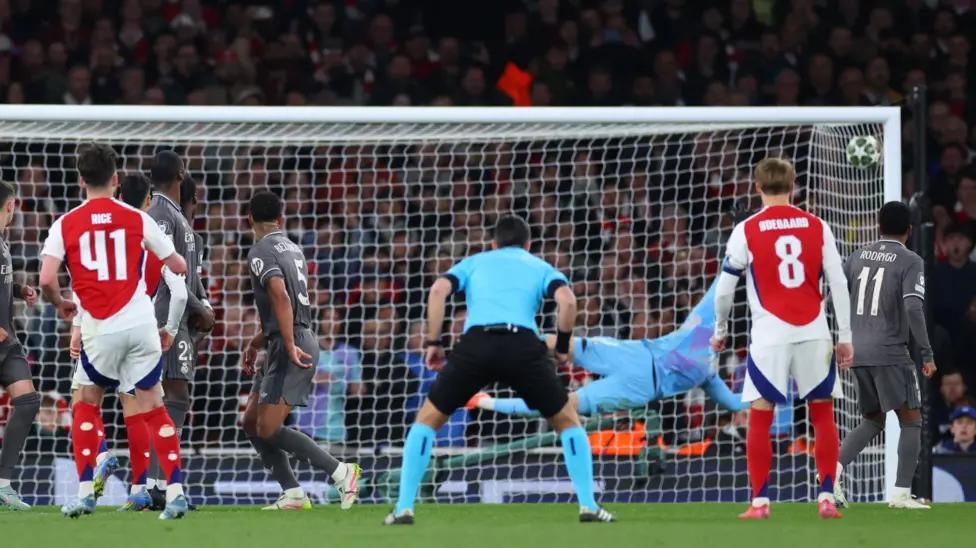Africa-Press – Lesotho. Arsenal midfielder Declan Rice’s two goals from free-kicks in the Champions League against Real Madrid provided a simple reminder.
There are not many better sights in football than watching a dead ball fly into the back of the net from a long distance.
Rice had never scored from a direct free-kick until Tuesday, when his two moments of brilliance helped Arsenal to a 3-0 victory in the first leg of the quarter-final at Emirates Stadium.
The first was curled around the wall and past goalkeeper Thibaut Courtois to put Arsenal ahead after 58 minutes, before Rice sent the ball bending into the top right-hand corner again 12 minutes later.
According to the stats, the chances of Rice scoring one of those goals were slim, never mind both. Former West Ham and England goalkeeper Rob Green said “both were impossible to save”.
But which one was better? What were the walls doing? And why are fewer free-kicks scored in football now?
Which one was better?
Via Opta’s expected goals (xG) model, Rice’s first free-kick had an xG of 0.037 (3.7%) and his second an xG of 0.063 (6.3%).
The probability of scoring both comes in at a combined total of 0.23%. Or put in layman’s terms, a one-in-435 chance.
But which one was better?
BBC pundit Green, who was at the Emirates for CBS, said it was the second.
“There is a series of things that happen. First of all, it is Courtois in goal,” said Green.
“Secondly, when someone shoots at what is called ‘the goalkeeper’s side’ (the part of the goal not covered by the wall) like Rice did and they score, then people go ‘oh, it’s the goalkeeper’s side’.
“Well, this time Rice does that against the best goalkeeper in the world, and at no point has anyone mentioned that Courtois should get anywhere near it.
“It is hard to think of how a right-footed player could have placed it any better, and with any more power than that. It was the definition of a perfect free-kick.
“My old goalkeeper coach at West Ham, Ludek Miklosko, used to call that top corner of the goal next to the stanchion ‘the spiders’ web’. When I worked on an England game with John Murray for BBC Radio 5 Live last month, he said that in Brazil they call it ‘where the owls sleep’. Every country has a different saying for it – we know it as ‘top bins’.”
Which one was harder to save?
Rice’s second free-kick carried an expected shot on target of 0.97, according to the xG Philosophy on X.
It meant that a goalkeeper would be expected to save it 3% of the time.
But Green said “both free-kicks were impossible to save”.
“You have got the best goalkeeper in the world, who is also massive with limbs that go on forever, yet he still got nowhere near either of them,” said Green.
“I was thinking ‘these are a long way out’, and he (Rice) just absolutely made mincemeat of them. It was incredible.”
At 6ft 7in, Courtois is a towering figure in the Real goal. He dived the right way for both shots but had no real chance of stopping them.
What about the walls?
Rice bent his first free-kick around Real’s four-man wall, but Green said to prevent that goal you may need to put three players outside of the post, which would have been “a farce”.
As for the second one: “What Arsenal did really well was their players put up their own wall in front of the Real wall to block Courtois’ view. But even so, I don’t think it would have made any difference whatever Real did.
“If it was open play and he just ran up and hit it like that then it would have gone in.
“It was just a pure strike, just a thing of absolute perfection and totally unstoppable no matter what the wall is doing.”
Bukayo Saka or captain Martin Odegaard would normally take Arsenal’s free-kicks, with the former scoring their most recent one – in October 2024. Odegaard last scored from a direct free-kick in September 2021 and has not converted any of his 30 attempts since.
“What I would say on both free-kicks is that neither of them would have happened if the ball was about four yards closer, because Saka or Odegaard would have taken them,” said Green.
“This is no disrespect to Saka or Odegaard, but they couldn’t do what Rice did because I don’t think they can kick the ball hard enough.”
Why are fewer free-kicks scored in football now?
Statistics show there has been a gradual decrease in the number of goals scored from direct free-kicks over the years.
A few specialists might stand out in your own mind – David Beckham, Cristiano Ronaldo, Lionel Messi and James Ward-Prowse.
But they are retired or nearing the end of their careers.
Does that make it a dying art?
For More News And Analysis About Lesotho Follow Africa-Press






